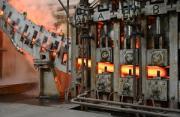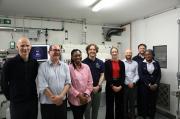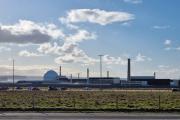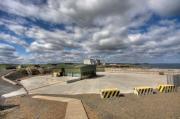
This site uses cookies, by continuing to use this site you accept the terms of our privacy policy
Feed 2.0 Loading...
New Director to Drive Forward Dounreay Clean-up
22nd February 2007
Simon Middlemas has been appointed as the new Director of the nuclear decommissioning site at Dounreay in succession to Norman Harrison. Simon has been Acting Director since August 2006 and prior to that he was Deputy Director. He joined Dounreay in 2004 as New Build Project Sponsor.
Welcoming the appointment, Norman Harrison , UKAEA's new Chief Executive,
said: "I am personally very pleased that Simon has been chosen as my successor. He has an exceptional grasp of every aspect of decommissioning at Dounreay and is totally committed to the site's success. He has already made a major contribution to Dounreay's new focus on project delivery and the recent site restructuring programme to prepare the site for competition. I am sure his appointment will be widely welcomed by the workforce and the community of Caithness."
Simon's career background is in the Royal Navy which he joined at Britannia Royal Naval College Dartmouth as a Midshipman in 1976. He then gained a degree in Electrical Engineering from the Royal Naval Engineering College and a Post Graduate Diploma in Nuclear Science and Technology. He joined the nuclear powered Polaris missile submarine, HMS Renown in 1982 followed by other sea jobs in submarines and time ashore working on their design and safety aspects. Prior to joining UKAEA in 2004 he was Naval Superintendent at the Vulcan Reactor Test Facility adjacent to Dounreay, for which he was awarded the OBE in 2003.
Simon Middlemas added: "I have long recognised Dounreay, with its dedicated and talented workforce and supply chain, as a site with great potential to establish the area's reputation in nuclear decommissioning internationally. We have a challenging time ahead in the run up to competition, and to succeed we must continue to drive up safety standards and maintain the great improvement in project delivery. I look forward to
the future knowing that Dounreay and Caithness will be recognised well beyond the Highlands as a lead site for decommissioning expertise."
Related Businesses
Related Articles
10/1/2025
Fusion-grade Steel Produced At Scale In UK-first
Researchers achieve 10x production cost savings for reduced activation steel. A United Kingdom Atomic Energy Authority (UKAEA) working group has successfully demonstrated the industrial scale production of fusion-grade steel.
22/12/2024
UKAEA To Lead The Creation Of A Robotics And AI Cluster
UKAEA will lead the creation of a new £4.9m nuclear robotics and artificial intelligence cluster across Cumbria and Oxfordshire. The robotics and AI cluster was announced by UK Research and Innovation (UKRI) as one of seven new projects to kickstart economic growth and address regional needs: www.ukri.org The robotics and AI cluster will link Cumbria and Oxfordshire to accelerate the decommissioning of the UK's legacy nuclear fission facilities and keep people out of hazardous environments.
5/12/2024
Diamonds Are Forever? World-first Carbon-14 Diamond Battery Made In Uk
The world's first carbon-14 diamond has been produced with the potential to provide power for thousands of years. Scientists and engineers from the UK Atomic Energy Authority (UKAEA) and the University of Bristol have successfully created the world's first carbon-14 diamond battery.
4/11/2024
UKAEA Monthly Newsletter Latest Edition
Find out what has been happening at UKAEA in our monthly newsletter. Read about our recent activities and upcoming events.
1/10/2024
UKAEA Newsletter - Edition 11 Published Today
Find out what has been happening at UKAEA in our monthly newsletter. Read about our recent activities and upcoming events.
23/5/2024
Corwm Visits Dounreay Nuclear Site
Members were given an overview of the scale of the problem and challenges faced in the decommissioning of the site. In the last week of March 2024, several members of CoRWM led by the Chair, Sir Nigel Thrift, made the long journey up to the North of Scotland to visit the Dounreay nuclear site, now managed by Nuclear Restoration Services.
5/3/2021
Design Contract Awarded For Dounreay Shaft And Silo Work
Dounreay has awarded an important waste clean-up contract to Jacobs as the site plans for the future of its deepest historic radioactive waste store. Jacobs and its supporting partners have been awarded a 6-year contract to provide a design management team to produce a fully integrated design for the shaft and silo project.
6/11/2013
Radiation dose to public from Dounreay reduces
Dounreay�s radioactive impact on the environment continues to fall, according to a report. The annual survey report �Radioactivity in Food and the Environment� (RIFE 2012) has recently been published and it can be read here - http://www.sepa.org.uk/radioactive_substances/publications/rife_reports.aspx The report uses data obtained from samples of air, fresh water, grass, soil, and locally sourced meat, fish, milk and vegetables during 2012.
6/4/2012
57,000 Tonnes Of Hazardous Materials Finally Dealt With At Dounreay
Dounreay today completed the destruction of one of the most hazardous legacies of Britain's earliest atomic research. A purpose-built chemical plant processed the last of 57,000 litres of liquid metal lifted from the primary cooling circuit of the experimental fast breeder reactor.24/3/2011



